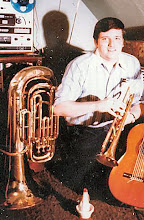1972 RCA Camden Records COS-9018(e)
(Stereo effect reprocessed from monophonic)
Side One
1. When the Saints Go Marching In
2. High Society
3. Farewell Blues
4. Darktown Strutters' Ball
5. Ballin' the Jack
Pete Fountain and Other All Star Dixielanders
Side Two
1. 'Way Down Yonder in New Orleans
2. Muskrat Ramble
3. 12th Street Rag
4. Tin Roof Blues
5. Won't You Come Home, Bill Bailey
Pete Fountain and Other All Star Dixielanders
Side Three
1. Original Dixieland One-Step *
2. Do You Know What It Means to Miss New Orleans *
3. Milenberg Joys **
4. Sweethearts on Parader *
* George Girard and His New Orleans Five
** Tony Almerico's Dixieland All-Stars
Side Four
1. Down by the Riverside
2. Jazz Me Blues
3. Cornet Chop Suey
Al Hirt and his Band
4. Just a Closer Walk with Thee
Al Hirt, Trumpet, with Orchestra Conducted by Marty Paich
Liner Notes: Martin R. Miller
WHEN THE SAINTS GO MARCHING IN (2 LP, Gatefold Cover)
Dixieland, the music that roared out of the South and became a major part of an authentic American art form called jazz, has itself always been a happy blend of a variety of musical strains. Conceived in cosmopolitan New Orleans, rendered street-wise in the notorious Storyville district, the precocious music, alternately "hot" or "blue," but always alive, was not to be contained in its birthplace. When Storyville closed forever in 1917, the new sound expanded rapidly beyond the Crescent City.
A popular music in the truest sense (it sprang from the work songs, religious "shouts" and gospel songs of emancipated slaves combined with voodoo rhythms and street music, plus elements of multi-faceted Creole sounds), Dixieland was performed and perfected at public functions - funerals, picnics, political rallies, dances, lawn parties, Mardi Gras. And because it was and still is "people's music," it encompasses the full range of human feeling. Like poetry, it is best when heard live so one can feel it.
The early poets of this music, the "giants" Charles "King" Bolden, "Bunk" Johnson and the legendary Louis Armstrong are gone, but new men have emerged who add to a growing tradition. Two of the best of the new poets are on this album. More importantly they play the music the way it is supposed to be heard - live. They perform, not in the rather antiseptic surroundings of a sound studio, but in the steaming clubs that also support the tradition.
AI Hirt and Pete Fountain are the "big" names on this album, but there are others who are considered all pro by their peers. For example, listen to George Girard and his New Orleans Five play the Original Dixieland One-Step, Sweethearts on Parade or Do You Know What It Means to Miss New Orleans.
Girard and his colleagues (who are also heard on the Pete Fountain sides) swing in the old style in their version of the One-Step. This cut features a fine series of solos, one in particular by clarinetist Harry Shields. Not once does the One-Step lag, and the live audience reaction at the end fits perfectly. On Sweethearts on Parade listen for the clear enunciation of the solos. The pleasant enough vocal serves as a bridge for the crisp play of Shields and the fluid clarity of trombonist Bob Havens.
Tony Almerico's Dixieland All-Stars contribute a rousing Milenberg Joys with audience vibrations surfacing in the background, which act as a spur to a fine group of musicians. Tune in to drummer Johnny Castaing's first solo.
Pete Fountain's group plays a string of the best known and revered numbers in the Dixieland repertoire. Pete and his men make you feel the room's excitement as they swing into such evergreens as Muskrat Ramble, High Society, 'Way Down Yonder in New Orleans, 12th Street Rag and the title song of this album, When the Saints Go Marching In.
But the big man on this album is none other than AI Hirt. Al, a big tree of a man, certainly has his roots in New Orleans. No one can see him or watch his antics on records, so his popularity can only be ascribed to professional competence and technique. Both are in abundance on this album. Hirt has described his style as "... the Nashville sound. It's a combination of pop, country western and jazz." Hirt sticks to Dixieland classics here. Listen to him handle Louis Armstrong's Cornet Chop Suey with deftness and power. Or feel the pre-funeral dirge, Just a Closer Walk with Thee. Follow him as he builds and swings in Down by the Riverside. The discipline is there, but so is the feeling.
So there you have it. The best of Dixieland played by the best and performed before live audiences in the city where it all began. All you have to do is join in.






Well said.
ReplyDelete